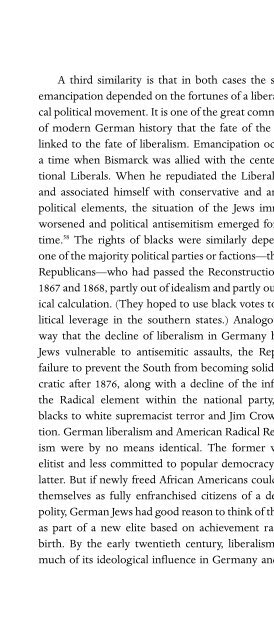Racism - A Short History - George M Fredrickson.pdf - WNLibrary
Racism - A Short History - George M Fredrickson.pdf - WNLibrary
Racism - A Short History - George M Fredrickson.pdf - WNLibrary
You also want an ePaper? Increase the reach of your titles
YUMPU automatically turns print PDFs into web optimized ePapers that Google loves.
NOTES to Pages 41–55<br />
46. The analogy to the Nazis is made by Netanyahu in Origins<br />
and by Yerushalmi in Assimilation and Racial Anti-Semitism.<br />
Both, however, give some weight to the difference between<br />
religiously based and secular constructions of innate Jewish<br />
difference.<br />
47. Poliakov, <strong>History</strong> of Anti-Semitism, 2:230–231.<br />
48. Quoted in Mörner, Race Mixture, 55–56.<br />
49. See Thornton, Africa and Africans, 269–271.<br />
50. See <strong>George</strong> M. <strong>Fredrickson</strong>, White Supremacy: A Comparative<br />
Study in American and South African <strong>History</strong> (New York,<br />
1981), 73.<br />
51. See references in nn. 24 and 43 above.<br />
52. On the confusion surrounding the Curse of Ham in the<br />
late medieval and early modern periods, see Benjamin Braude,<br />
“The Sons of Noah and the Construction of Ethnic and Geographical<br />
Identities in the Medieval and Early Modern Periods,” William<br />
and Mary Quarterly 54 (1997): 103–142. On the uses of the curse to<br />
justify radical status inequality within Europe, see Paul Freedman,<br />
Images of the Medieval Peasant (Stanford, 1999), 86–104.<br />
53. Sanders, Lost Tribes, 62.<br />
54. Benjamin Braude, “Race and Sex: What Happened to<br />
Cross-Color Generation in the Eighteenth Century?” (paper presented<br />
to the Conference on Sexuality in Early America, Philadelphia,<br />
June 1–3, 2001), 17–18.<br />
55. See Thomas Virgil Peterson, Ham and Japheth: The Mythic<br />
World of Whites in the Antebellum South (Metuchen, N.J., 1978).<br />
Blackburn, in New World Slavery (72–73), criticizes David Brion<br />
Davis for contending that the Curse of Ham had little importance<br />
as a justification of slavery before the late eighteenth and nineteenth<br />
centuries (Slavery and Human Progress [New York, 1984], 337<br />
n. 144). In my view the curse was not securely linked to the polemical<br />
defense of slavery until it became an alternative rationale<br />
for southerners who resisted scientific racism on fundamentalist religious<br />
grounds.<br />
56. I have described this transition elsewhere. See “Social Origins<br />
of American <strong>Racism</strong>,” in The Arrogance of Race: Historical Per-<br />
176
















